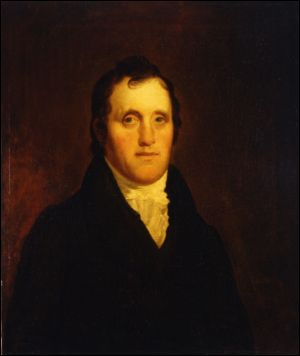1774-1825
Associate Justice of the New York Supreme Court of Judicature, 1804-1807
Daniel D. Tompkins was born in Westchester County, New York on June 21, 1774. He was educated at the Academy of North Salem where he was recognized as an exceptional scholar and a gifted essayist. Following his 1795 graduation from Columbia College, Tompkins studied law in the office of Peter Jay Munro in New York City. He was admitted to the bar in 1797 and quickly rose to prominence — he was a delegate to the New York State Constitutional Convention in 1801 and a member of the New York State Assembly in 1804.
Tompkins resigned from the Assembly in July 1804 to accept an appointment as an Associate Justice of the New York Supreme Court of Judicature. There he authored 29 opinions, including the majority decision in the famous fox hunting case, Pierson v. Post (1805) and a dissenting opinion in the double jeopardy case of People v. Barrett and Ward (1806).
Justice Tompkins resigned from the New York Supreme Court in July 1807 to become the fourth Governor of New York. He was re-elected Governor in 1810, 1813 and 1816 and was a strong supporter of legislation to improve schools, outlaw slavery in New York and reform the penal code to reduce the number of offenses punishable by death. Governor Tompkins resigned from office on February 24, 1817 to assume the office of Vice President of the United States to which he had been elected in 1816 on a ticket with James Monroe. President Monroe and Vice President Tompkins were re-elected in 1820 for a second term, following which Daniel D. Tompkins retired to his residence on Staten Island. He died there on June 11, 1825.
A plaque in his memory was installed in the former Capitol building in Albany and another in Tompkinsville Park on Staten Island, the inscription on which reads:
Daniel D. Tompkins, 1774 – 1825; Governor of the State of New York, 1807-1817; Vice-President of the United States 1817-1825; and a resident of Staten Island. Among many meritorious acts he aided the passage of the law abolishing slavery within the state, added to the fortifications at the Narrows during the War of 1812; founded the Village of Tompkinsville; laid out the Richmond Turnpike; gave the land on which the Dutch Reform Church was built and established the first steamboat ferry from Staten Island. In 1824 he and Dr. Van Pelt entertained General Lafayette on Staten Island.
Both Tompkins Square Park in New York City and Tompkins County, New York, are also named for him.
Sources
L. Edward Purcell, ed. Vice Presidents: A Biographical Dictionary.
United States Senate: http://www.senate.gov/artandhistory/history/common/generic/VP_Daniel_Tompkins.htm

